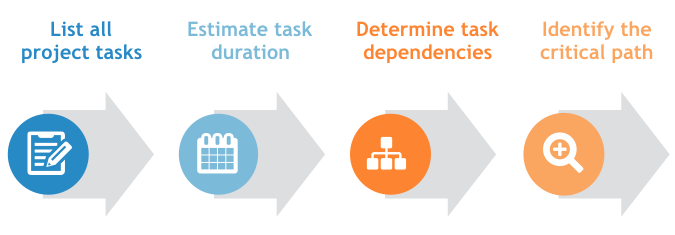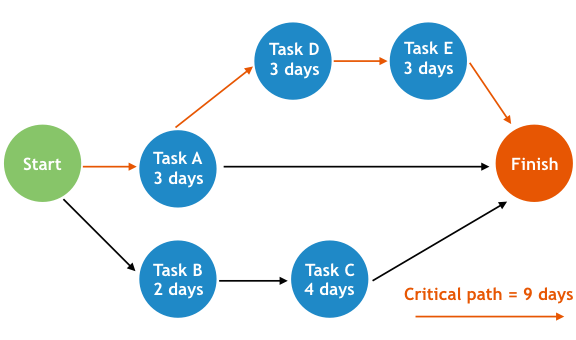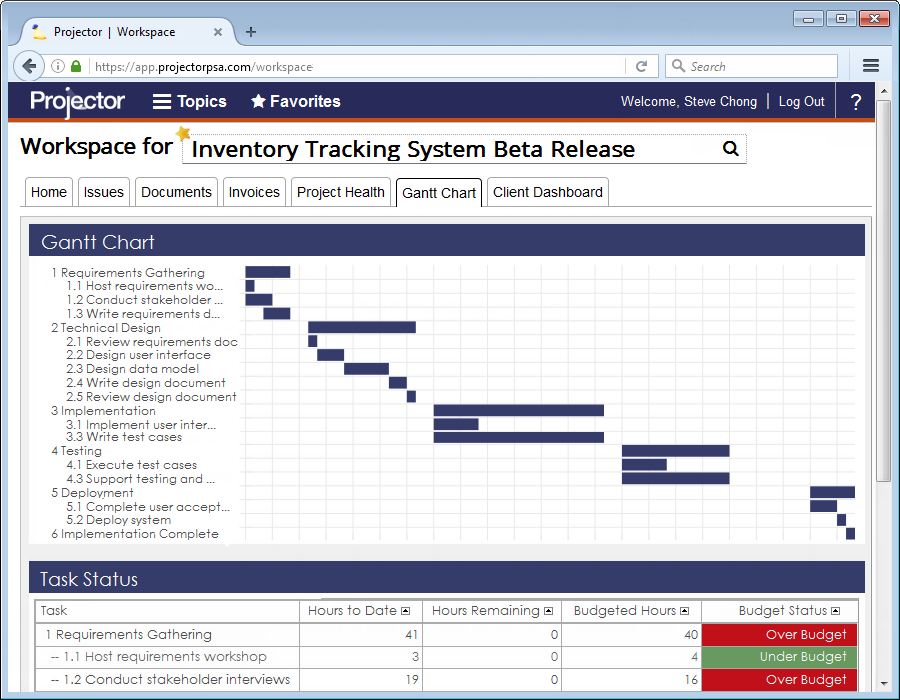How Understanding Critical Path Can Drive Project Management Success
It’s easy to assume that every task that’s in a project is “critical”—after all, milestones wouldn’t be met and requirements wouldn’t be delivered without completing each task along the way.
But when it comes to project management, evaluating the “critical path” means identifying the essential activities that drive the project timeline.
This can be a tough concept to wrap your head around.
To help explain critical path and its role in project management, we interviewed Steve Chong, chief operating officer and product manager for Projector PSA. He detailed how the critical path method (CPM) can impact project success.
His insights help us address the following questions:
(Click on a link below to jump to that section.)
How Is CPM Used in Project Management?
What Tools Are Available to Help Identify Critical Path?
How Can Critical Path Software Benefit Project Managers?
1. What Is Critical Path?
The longest sequence of tasks that determine the project schedule.
CPM, also called “critical path analysis,” is a project management technique that involves:
Listing all the tasks required to complete a project
Estimating the duration of those tasks
Determining the relationship, or dependency, between each task
Identifying the “critical” tasks driving the project timeline

A project’s critical path is the longest series of tasks that determines the minimum amount of time required to complete a project.
In the example below, tasks A, D and E form the longest sequence of tasks, and thus determine the project’s critical path. This makes the minimum time required to complete the project nine days.
Critical Path Example

Determining the critical path allows managers to evaluate which tasks are “critical,” meaning they have the potential to impact the project deadline. They can also see which are non-dependant or have enough float, or slack, to be non-critical.
This distinction is important for two reasons:
Since not every task is dependent on those preceding it, not every task will be on the critical path.
The sequence of tasks on the critical path are so connected that if one task is delayed, it will set back the entire project.

“Any slippage in tasks on the critical path will result in slippage of the project as a whole. Delays in tasks outside the critical path won’t result in slippage of the whole project unless those delays become so acute that these tasks become the new critical path.”
Steve Chong, chief operating officer and product manager for Projector PSA
2. How Is CPM Used in Project Management?
To calculate project duration, track progress and evaluate schedule accuracy.
Critical path analysis should be performed during both project planning and tracking:
Planning: Estimate the project schedule more accurately
Tracking: Monitor progress and determine if the project is on track to meet its deadline
Project Planning
According to Chong, critical path is typically calculated during project planning, using a detailed work breakdown structure (WBS).
The WBS includes a hierarchal list of activities required to complete the project (tasks), the time estimated for each task to be completed (duration) and whether or not tasks can be started until previous tasks are completed (dependencies).

“CPM takes these inputs and models the project as a network … with a defined starting and ending point. It then runs through all the possible paths that can be taken through the network to get from the start to the end and finds the longest path, which it designates the critical path.”
Steve Chong, chief operating officer and product manager for Projector PSA
There are several project planning tools available to help managers evaluate critical path, such as PERT and Gantt charts.
PERT charts are useful data visualization tools that project managers use to diagram the WBS and create accurate project schedules. This process highlights hierarchies and task dependencies.
Gantt charts are popular data visualization tools that are often used in conjunction with PERT charts. Project managers use Gantt charts to not only visualize the project schedule, but track progress during project execution.


Gantt chart in Projector
Project Tracking
Once a project is underway, it’s a good practice for managers to continuously revisit the project’s critical path. Teams may complete tasks earlier than expected or may suffer unavoidable setbacks, both of which can affect the project end date.
Chong recommends that managers re-calculate the critical path several times over the course of the project to account for these changes.
Due to the frequency of these re-calculations, it can be time-consuming for managers to conduct critical path analysis using manual methods. Managers may be better served using critical path software that automates this process and allows for increased visibility into team performance.
According to Chong, staying on top of a project’s critical path throughout its lifecycle allows managers to prioritize time and resources for those tasks that are most likely to impact the deadline.

“Rather than paying attention to making sure tasks off the critical path don’t slip or applying additional resources to accelerate a non-critical task, project managers can keep their eyes on the tasks that matter more.”
Steve Chong, chief operating officer and product manager for Projector PSA
3. What Tools Are Available to Help Identify Critical Path?
Stand-alone critical path calculators or project management platforms with built-in CPM capabilities.
Critical path software is often used to describe two types of tools: stand-alone critical path applications or comprehensive project management (PM) platforms with critical path functionality.
Common capabilities of critical path software include:
Critical Path Capabilities
Critical path calculator | Automatically calculates critical path in regard to number of tasks, estimated task start date/end date and float. |
Data visualization | Tools such as PERT and Gantt charts help managers visualize vital tasks on the critical path via highlighting and color-coding. |
Cascading changes | Allows managers to update due dates and/or drag and drop tasks on the critical path. Those updates are then reflected in subsequent tasks on the project schedule. |
Notifications | Managers can set up email or in-app alerts to notify themselves and team members of upcoming deadlines and overdue tasks. |
Integration with other systems | Standalone calculator tools, PERT or Gantt charts often integrate with more robust PM systems, allowing for greater visibility into team schedules and risk management plans. |
Free, online critical path calculators, such as this one from the University of Michigan-Dearborn’s College of Engineering & Computer Science, can help managers evolve their critical path analysis and create more accurate project schedules.
Project teams in need of a greater depth of functionality and visibility into resource availability may opt for PM software with built-in critical path capabilities.
Examples of highly rated PM solutions include:
| |
| |
|
Chong’s own Projector software integrates with Microsoft Project to address their users’ multi-faceted needs:
“For our clients, which are firms in the professional services industry, the gathering of information that feeds into the CPM model (estimates, time invested and effort remaining) as well as the output of the CPM model (invoicing clients, revenue recognition and status monitoring) is as important as the act of calculating the CP itself.”
4. How Can Critical Path Software Benefit Project Managers?
Automate calculations, increase transparency and improve risk management.
Critical path software can benefit managers in several ways, including:
 Increasing transparency:
Increasing transparency:
Integration with other systems can provide greater visibility into current and upcoming schedule constraints, team skill sets and availability. This allows managers to create more accurate project plans and stay on top of changing schedules.
 Encouraging communication:
Encouraging communication:
Managers can easily share critical path analysis with stakeholders and teams, especially when using cloud-based PM tools. Publicizing progress along the critical path not only motivates people to meet deadlines, but also encourages team members to better communicate if a deadline is in danger of slipping.
 Improving risk management:
Improving risk management:
Applying critical path analysis during project planning enables managers to better staff their projects and keep a closer eye on dependant tasks that could impact that project schedule.

“By consciously assigning more seasoned, trustworthy resources to tasks on the critical path (and keeping them off non-critical path tasks), a project manager may be able to lower the variability and risk inherent in the time it takes to deliver the project.”
Steve Chong, chief operating officer and product manager for Projector PSA
Next Steps
To learn more about project planning software, visit our Buyer’s Guide to compare tools and read reviews.
Or, email me at eileen@softwareadvice.com. I’m available to answer any questions you might have about critical path analysis or CPM software.


